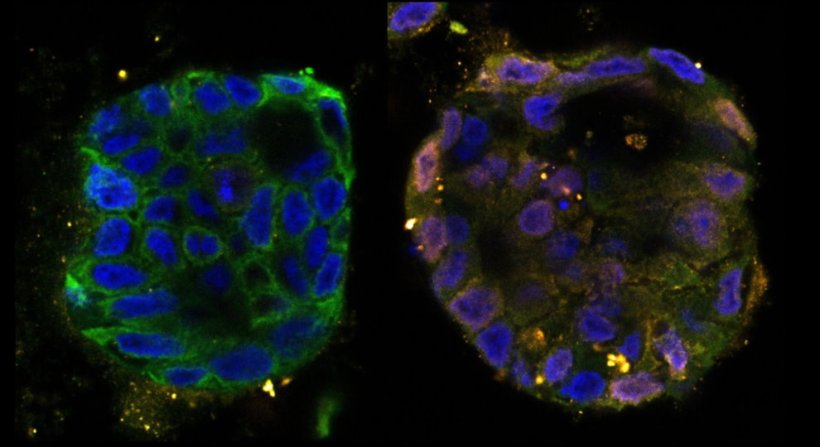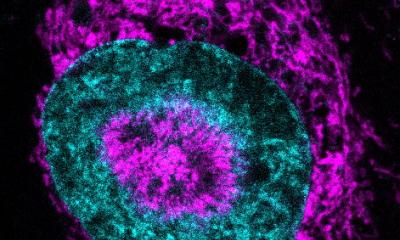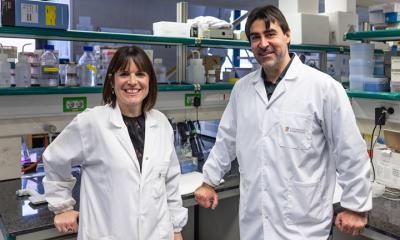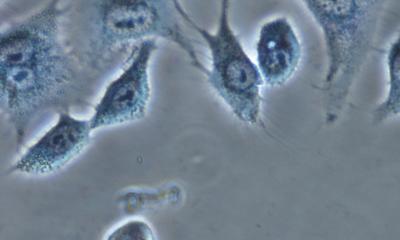
Image source: Netherlands Cancer Institute
News • Research on DNA danage
Surprise finding on cancer cell death to impact therapies
Researchers from the Netherlands Cancer Institute, led by Thijn Brummelkamp, have uncovered a completely new way in which cancer cells die: due to the Schlafen11 gene.
"This is a very unexpected finding. Cancer patients have been treated with chemotherapy for almost a century, but this route to cell death has never been observed before. Where and when this occurs in patients will need to be further investigated. This discovery could ultimately have implications for the treatment of cancer patients." The researchers published their findings in Science.
In the event of DNA damage, SLFN11 shuts down the protein factories of cells: the ribosomes. This causes immense stress in these cells, which leads to their death. The new route we discovered completely bypasses p53
Nicolaas Boon
Many cancer treatments damage cell DNA. After too much irreparable damage, cells can initiate their own death. High school biology teaches us that the protein p53 takes charge of this process. p53 ensures repair of damaged DNA, but initiates cell suicide when the damage becomes too severe. This prevents uncontrolled cell division and cancer formation.
That sounds like a foolproof system, but reality is more complex. "In more than half of tumors, p53 no longer functions," says Thijn Brummelkamp. "The key player p53 plays no role there. So why do cancer cells without p53 still die when you damage their DNA with chemotherapy or radiation? To my surprise, that turned out to be an unanswered question." His research group then discovered, together with the group of colleague Reuven Agami (both research groups are part of Oncode Institute), a previously unknown way in which cells die after DNA damage. In the lab, they administered chemotherapy to cells in which they carefully modified the DNA. Thijn: "We were looking for a genetic change that would allow cells to survive chemotherapy. Our group has a lot of experience in selectively disabling genes, which we could perfectly apply here."
Recommended article

Article • Awareness
Focus on cancer
From solid tumors to metastatic carcinomas and leukemia: cancer is among the most common causes of death. Keep reading for latest developments in early detection, staging, therapy and research.
By switching off genes, the research group found a new pathway to cell death headed by the gene Schlafen11 (SLFN11). Principle investigator Nicolaas Boon: "In the event of DNA damage, SLFN11 shuts down the protein factories of cells: the ribosomes. This causes immense stress in these cells, which leads to their death. The new route we discovered completely bypasses p53."
If this form of cell death also proves to play a significant role in patients, this finding will have implications for cancer treatments
Thijn Brummelkamp
The SLFN11 gene is not unfamiliar in cancer research. It is often inactive in tumors of patients who do not respond to chemotherapy, says Thijn. "We can now explain this link. When cells lack SLFN11 they will not die in this manner in response to DNA damage. The cells will survive and the cancer persist."
"This discovery uncovers many new research questions, which is usually the case in fundamental research," says Thijn. "We have demonstrated our discovery in lab-grown cancer cells, but many important questions remain: Where and when does this pathway occur in patients? How does it affect immunotherapy or chemotherapy? Does it affect the side effects of cancer therapy? If this form of cell death also proves to play a significant role in patients, this finding will have implications for cancer treatments. These are important questions to investigate further."
Source: Netherlands Cancer Institute
17.05.2024











